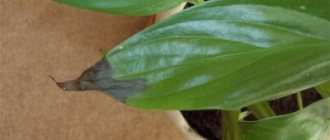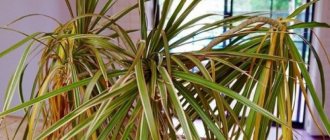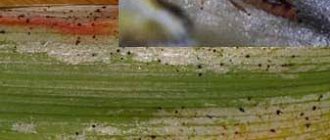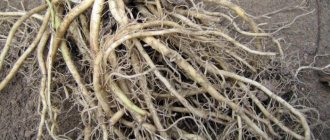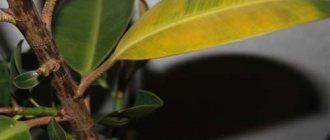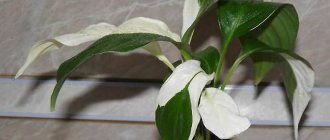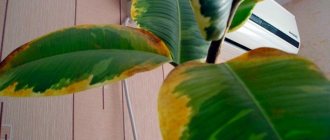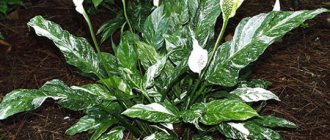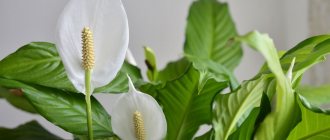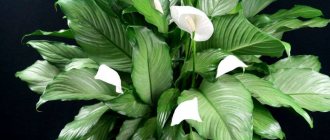Keeping spathiphyllum at home - is it a demanding plant or not?
Spathiphyllum is a member of the Araceae family, which includes about 45 species. Under natural conditions, it can be found in the Philippine, Brazilian and Venezuelan territories.
Diseased spathiphyllum
Its genus includes perennials, the main difference of which is the absence of stems. The foliage begins to grow directly from the root system and can be oval or lanceolate. Spathiphyllum blooms in spring days; the inflorescence is represented by a spadix covered with a kind of blanket. After the end of the budding period, it is cut short.
Spathiphyllum has gained popularity among flower growers due to its complete unpretentiousness and lack of excessive care requirements. Decorative leaf blades played an important role in the spread of the flower. Despite the small requirements, it needs high air humidity and abundant watering. This approach will allow him to develop and grow normally.
Important! Violation of the recommendations from breeders given in the description of spathiphyllum can lead to the development of various diseases and attacks by insect pests. It cannot be placed on the windowsill and remembered twice a month about its existence during irrigation or fertilizing. With this approach, it can droop, wither and dry out.
Healthy and blooming spathiphyllum
What a healthy spathiphyllum should look like
Spathiphyllum is a perennial belonging to the Araceae family. It has no stems, bright green leaves grow directly from the root, in a bunch. They are solid, elongated, large. They are oval or lanceolate in shape. The middle vein stands out strongly on them and the lateral veins, running parallel to each other, are less prominent.
The name of the flower comes from the Greek words “spate”, meaning “spread”, and “phyllon” - leaf and describes the appearance of the bract-spread. With its base it covers the inflorescence-cob on a long peduncle.
Healthy specimens usually bloom in spring and last for several weeks. Repeated periods of emission and blossoming of buds are also common - in summer and autumn, occasionally even in winter, during the dormant period of the plant.
Spathiphyllum: leaves turn yellow, how to eliminate the cause
Why do the tips of leaves on indoor plants dry out?
A change in color can be observed in specimens that were still healthy yesterday. The problem quickly spreads across the sheet metal and arises from many factors. The general clinical picture is similar for different lesions, so the likelihood of misdiagnosis is high. Ignoring the symptoms can lead to the death of spathiphyllum in the shortest possible time.
Flower growers distinguish the following sources of pathology and offer separate treatment methods for each option:
- lack of attention during courtship. After active budding, spathiphyllum may become tired and need time to recuperate. The lower foliage on the bush will begin to actively turn pale, wither and wither. As first aid, transplantation into a larger pot with fresh soil and fertilizing with a special composition are used;
- wrong approach to lighting. Prolonged exposure to direct sunlight leads to damage to the green part. Sunburn occurs when there is no shade in hot weather;
- increased air dryness. Spathiphyllum does not tolerate central heating. The solution to the problem is to move the container away from the batteries, use a humidifier, and regularly spray. Some housewives prefer to place an aquarium or container with liquid next to the flower.
Leaves on spathiphyllum turn yellow
Note! Insufficient light also negatively affects the condition of spathiphyllum. Leaf blades change color, development and growth processes slow down, flowering may be completely absent.
How to keep your plant healthy
First of all, you should adhere to the rules for caring for spathiphyllum at home, creating the necessary conditions for it:
- keep the flower in diffused light - on a northern or northwestern windowsill, do not place it in direct sunlight;
- maintain the temperature in the room with the plant at +23-27 °C in the summer, and in winter reduce it to +16-17 °C;
- achieve high humidity. You can use different methods - spray the spathiphyllum twice a day (but you need to wipe the leaves rarely, no more than once a month), place the flower pot on a tray with constantly damp pebbles, moss, expanded clay or brick chips, or next to a large aquarium, a bucket of water . Loves spathiphyllum and warm showers once or twice a month;
- Watering is necessary abundantly, but not before the top layer of soil in the pot dries completely. Water on average once every three days in summer and half as often in winter. Use settled, soft water (if necessary, soften with a drop of lemon juice), if possible, melt or rain water, at room temperature;
- Replant the plant in fresh soil in time.
Based on the appearance of the bush, you can determine in time what to do to provide it with nutrition: choose the necessary fertilizers or urgently replant the plant in a fresh fertile substrate. If the plant looks healthy, you need to use mixtures for flowering indoor crops.
Spathiphyllum: leaves turn black around the edges, what to do
Why do the tips of dracaena leaves dry out - what to do
The sources of development of non-standard appearance include a number of factors. Botanists advise first understanding the reason for the blackening of the leaf blades and only then taking up the resuscitation of the affected specimen.
Why do the tips of all the leaves of Spathiphyllum turn black and how to save it:
- freezing of the root system. The tropical flower prefers to grow at temperatures not lower than 15-18 °C. The pot needs to be moved closer to the heat source, not forgetting about regular spraying;
- incorrectly selected soil. Spathiphyllum needs loose, easily permeable soil. A dense and compacted substrate causes moisture stagnation, provoking the development of rot in the root system. The consequence of decay is blackness on the green part;
- low air humidity. In the first weeks, yellowing and drying of the foliage are observed, and a little later it turns black. The exotic plant requires watering and spraying throughout the calendar year. Spathiphyllum will perceive a break as a drought and will begin to get rid of excess leaves;
Spathiphyllum leaves turn black
- excess fertilizer. Excess nutrients are no less destructive than their deficiency. To resolve the issue, you need to take a break of one and a half months, and then adhere to the dosages indicated by the manufacturer on the nutrition label;
- waterlogging. Occurs when the number of waterings is incorrectly calculated. In summer, the procedure is performed every 3-4 days, in winter - less often. Before watering, you need to make sure that the top layer in the pot is dry enough;
- sunburn. Prolonged exposure to the sun leads to serious damage to the leaves of spathiphyllum. The affected parts must be removed and the container moved to partial shade until complete recovery.
Important! Immediately after acquiring a new specimen for the collection, you should not feed it. At least one and a half months are given for the adaptation of spathiphyllum. When selling, plants are planted in nutritious soil; it retains its properties throughout the specified period.
Spathiphyllum: home care, why the tips of the leaves dry out
Why do aloe leaves turn yellow and leaf tips dry out?
There are several versions of this anomaly. Experts advise finding the source of the problem and immediately treating spathiphyllum. The list of possible factors includes:
- incorrect calculation of fertilizing. If the supply of minerals is insufficient, a similar picture can be observed: the foliage will gradually begin to dry out. For therapy, a nitrogen-potassium-phosphorus mixture is used;
- water scarcity. Initially, the leaf plates lighten and become yellow, and later begin to dry out. For a tropical plant living in a marine climate, dry air is very harmful. To compensate for insufficient moisture, the foliage should be regularly wiped with a cotton pad soaked in liquid and sprayed with a spray bottle. The tray can be filled with pebbles, sand and expanded clay and only then pour water into it and place it under the pot;
Leaves dry around the edges
- excessive humidity. It also causes the tips of spathiphyllum foliage to dry out. Excessive moisture, compacted soil and lack of drainage layer provoke stagnation of water. The root system begins to rot and the leaf blades dry out. To solve the problem, take a double container and line the space between the walls with damp peat or moss.
Note! Being in direct sunlight or in a cold room is also not suitable for spathiphyllum. If it stays in these conditions for a long time, it will begin to die. The only way to avoid tragedy is to move the flower to a more suitable place and protect it from sunlight.
What causes spathiphyllum leaves to curl?
Leaf blades begin to curl and new ones begin to shrink when changes in care regime are necessary: watering, lighting or nutrition. Sources of the problem include:
- reduced room temperature. The leaves acquire dark shades, even burgundy-green. They begin to wrap themselves in peculiar cocoons. The deviation is caused by being in a place where there are constant drafts, or air from the air conditioner hits the plant;
Spathiphyllum leaves curl
- lack of lighting. The problem is relevant in the winter months or during prolonged and prolonged rains. To correct the situation, use a specialized ultraviolet lamp; it will help compensate for the lack of sunlight;
- aphid damage. The attack of the parasitic insect is suppressed by insecticides. Experienced flower growers prefer to use Actellik, which gives the desired effect after the first procedure.
For your information! Some varieties of spathiphyllum have an innate predisposition to folding leaf plates. This process has the opposite effect - after some time they unfold independently, without outside help.
Why do spathiphyllum leaves turn pale?
The paleness of the foliage signals violations in the care of spathiphyllum. Whiteness occurs in the first stages of the lesion, followed by yellowness and dark spots. The specimen becomes rotten, dries out and dies.
If the source of the disease is correctly identified and resuscitation measures are carried out in a timely manner, the plant has a chance of recovery.
Note! Experts note that the list of primary symptoms of the lesion includes a decrease in the intensity of the green tone, loss of elasticity and the formation of yellowish spots along the entire length of the foliage.
Common sources of the anomaly are presented below.
Increased by dry air
Spathiphyllum needs regular ventilation of the room, but provided there are no drafts. A stuffy room negatively affects its general condition, as does the close location of central heating radiators. It is better to move it to a ventilated place, away from the heating system.
Incorrect watering - excessive or insufficient soil moisture
Stable overflow is one of the common root causes of leaf discoloration. To check suspicions, it is enough to inspect the soil; it should be loose, soft and slightly moist.
During replanting, you need to check for drainage holes in the new container. If they are absent, the liquid will constantly stagnate, causing the roots to rot and the substrate to deteriorate.
Important! Excessive volumes of water must be removed from the pan immediately.
Fungal infections
The crop is susceptible to fungal attack; common ones include rust and black spot. They can only be controlled with fungicidal solutions. Therapy begins when spots of a grayish, yellowish or brownish tint appear. In affected spathiphyllums, the areas damaged by rot are cut off, and the cut areas are treated with crushed charcoal or activated carbon and a solution of potassium permanganate. In the future, the flower needs to be transplanted into a new container with fresh soil.
The green part is treated with chemicals against fungal infections. During therapy, you can feed the flower with zircon and epin, which will help boost the plant’s immunity, strengthen its fight against infection, and revive it.
Parasitic insects
The primary destruction of pests is carried out by mechanical cleaning of the foliage using a soap solution and a cotton pad. At the same time, treat the outer sides of the pot, the window sill and the tray. The solution is left on the flower for 2 hours, then bathed in the shower.
If spathiphyllum is massively affected, this method will not be successful; it is necessary to destroy the parasites with insecticidal compounds. They are effective and fast; secondary treatment is required after a week. After therapy, most flowers are successfully restored.
Note! During flowering, spathiphyllum is depleted, and the subsequent period requires increased attention. It requires timely application of fertilizers consisting of nitrogen-potassium-phosphorus elements. They are able to compensate for the deficiency of substances, support the flower and extend the budding time.
Exotic spathiphyllum has taken its rightful place in the homes of indoor plant lovers. In addition to its appearance, it has the ability to rid your home of benzene, formaldehyde and accumulated toxic substances. The plant is deservedly considered not only beautiful, but also useful.
When asking why spathiphyllum leaves turn yellow, you should not expect high-quality air purification. The green doctor requires help from his owner; he will have to be resuscitated. But if you care for it properly, the leaves will not darken, become pale or yellow.
Reasons for changes in the appearance of a plant
By changing the color saturation and the appearance of spots on the foliage, spathiphyllum often signals a deterioration in its condition. Leaves turn yellow and turn pale for various reasons:
- first of all - due to improper care;
- problems can cause illness, parasite infestation.
Since the culture is highly immune to diseases, the latest problems are, in fact, also a consequence of long-term gross violations of the rules for growing spathiphyllum. Nevertheless, the flower’s endurance and ability to recover even after severe damage are amazing. After organizing proper care for the spathiphyllum, it changes its pale leaves to bright green and resumes flowering.
